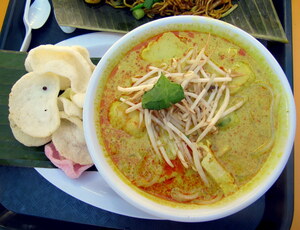Ethnic restaurant lacks authentic tastes
We’re a country of immigrants. And regardless of how integrated we are with American culture, when it comes to food, there is still nothing like a meal reminiscent of that of your mother country’s. It may be something mundane, simple and cheap, but the nostalgia it evokes is priceless. Taste is important, but, when it comes to your own ethnic food, authenticity is key.

Malay fare · Banana Leaf’s rojak (top) and laska (above) lacked the intensity of true Singaporean dishes. - Sophia Lee | Daily Trojan
As a multicultural city, Los Angeles is a great place for ethnic food. You don’t have to go far to find good Mexican, Chinese, Japanese or Korean restaurants, but, with other areas such as Southeast Asia, the hunt for cuisine gets a little harder. Thus, the disappointment of Banana Leaf, a Singaporean eatery in the corner of the Grove’s Farmers Market, was not too surprising.
Banana Leaf’s location has a touch of familiarity for Southeast Asians. Situated in the middle of a noisy, bustling outdoor food court, it is very much like the typical street markets of Singapore, which are open-air complexes with a variety of stalls selling cheap, fast food.
Banana Leaf is certainly not a fancy restaurant. It consists of one stall with a few tables and stools for open seating. The service was rude and crass — which was oddly desirable and expected in such an environment, especially since it reinforced nostalgic memories of Singapore’s own boisterous food vendors.
The restaurant’s minimal menu, however, was not so nostalgic. It sorely lacked many of the most traditional dishes of Singapore. In fact, self-proclaiming themselves as a Singaporean eatery is misleading because the majority of the dishes are actually Indonesian or Malaysian. Of course, Singapore — like the United States — is a cultural melting pot, but there are ubiquitous Singaporean dishes like char kway teow, bak kut teh and hainanese chicken rice that were all suspiciously absent from the menu.
Still undeterred in wanting a true Singaporean meal, I tried to order dishes that are prevalent in traditional hawker centers: rojak, laksa and chicken mee goreng. The rojak was nothing more than a sloppy salad of spinach, jicama, pineapple and bean sprouts in a watery sweet and sour sauce.
A true rojak resembles nothing like a healthy salad — it has no greens, but is chock-full of ground peanuts, deep-fried dough and a sweet, viscous sauce that sticks to the roof of your mouth. It is supposed to be a high-carb, high-fat, non-diet salad, but the rojak served in Banana Leaf was — in true California fashion — a healthified knockoff.
The laska, a coconut curry noodle soup, fared no better. It was watered down until it tasted like ditch water cooked with spices. It lacked the pungent, fiery, sinus-clearing kick and intensity of a true Singaporean laksa. The condiments, however, were pleasantly familiar: chewy fish cake slices and crunchy keropoks, which are deep-fried crackers made from dried shrimp.
Fortunately, the chicken mee goreng turned out to be much better than the other two dishes. Mee goreng, or “fried noodles” in Malaysian, is a spicy, fried egg noodles dish with onions, vegetables and egg. The noodles were cooked over high heat so there were bites of crunchiness, just the way a street vendor would make it. The spice level was satisfactory, and the chicken, though tough and stringy, was nicely seasoned. Was it authentic? Hard to say, as mee goreng tastes different in every stall, and every family has its own recipe, but it certainly was the most authentic out of the three dishes I ordered.
To be fair, authentic cuisine is hard to recreate in any foreign country. In the United States, more specifically, many of the necessary spices cannot be found and the intensity and flavor of dishes will inevitably be toned down to suit American palates.
Banana Leaf actually boasts high ratings on popular review sites such as Yelp.com, and business was strong even mid-afternoon. Ultimately, Banana Leaf might be a good place if you want an adventurous bite to eat but, for those seeking a nostalgic trip back to your Southeast Asian hometown, skip this place and keep looking.

It will be nearly impossible to recreate foods exactly as they are in other regions of the world. Something as simple as the poor quality of the water in some areas of the New England area makes for the best bagels. Go to Texas and try to recreate them and you can make a good product, but it will not be the same.